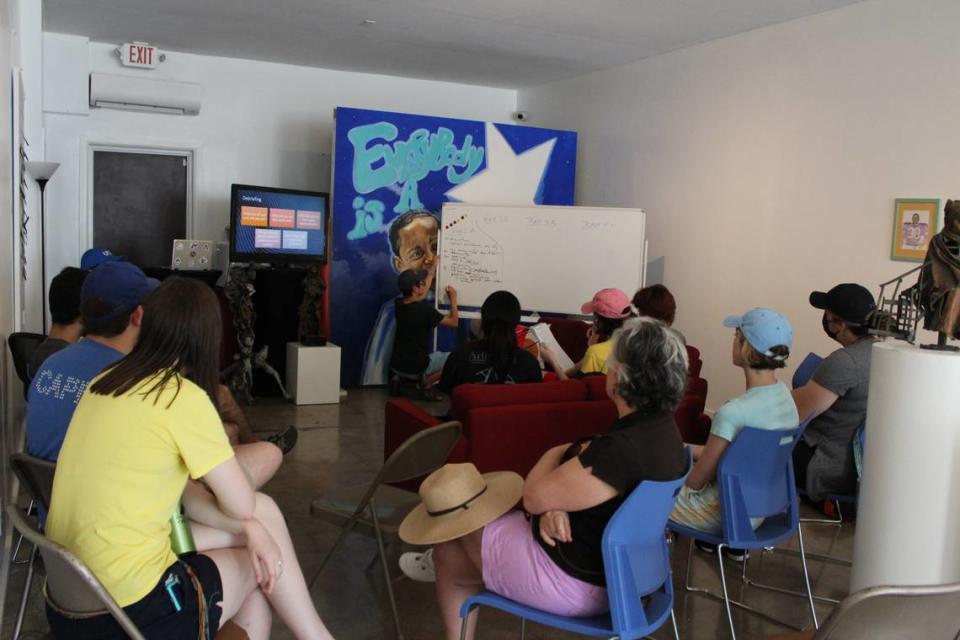How friendly are Arlington streets for pedestrians and cyclists?
A new advocacy group is advocating for a more pedestrian- and cyclist-friendly city, and its members want to help residents assess their neighborhoods’ needs.
Members of Walkable Arlington, a fledgling nonprofit led by UT Arlington students, are compiling recommendations for city government to improve walking and biking downtown. Preliminary ideas are as simple as installing bike racks or changing pedestrian walk times, and longer term, including converting Center and Mesquite streets to two-way and incorporating protected bike lanes.
Several of the ideas are already folded into city master plans and studies. However, Tony Pham, a coordinator with Walkable Arlington, said the group would like to see more progress made based on city studies.
“There are so many ideas and plans that the city has already looked through and approved, but it just needs a push from someone like us to actually get it implemented,” he said.
Pham and other group leaders are compiling recommendations from Walkable Arlington’s first large-scale walk audit. About 14 people, including council members and residents, spent June 26 walking over three miles of downtown-area roadways. The groups returned by lunchtime with a whiteboard full of problem areas and possible solutions.

The city council has taken an interest in the group’s work. District 7 council member Victoria Farrar-Myers and District 5 council member Rebecca Boxall participated in the audit and put members in contact with city employees to go over recommendations. More council members have asked Walkable Arlington to share their findings.
Pham said the group has been encouraged by the ongoing conversations with folks in city hall.
“If we’re able to get ourselves connected to these thinkers and doers, we are definitely going to get somewhere,” he said after the walk June 26.
The Metroplex is the 31st deadliest region for pedestrians, according to Smart Growth America’s Pedestrian Danger Index, with 1,160 deaths in the area between 2010 and 2019. Carinsurance.org rated Arlington the 13th deadliest city for cyclists.
Walkable Arlington leaders hope to conduct audits throughout the city. Members have identified inconsistent or nonexistent sidewalks in east and north Arlington, Pham said.
“If we only focus on downtown, we are going to be leaving out so many others out of the equity of our vision,” Pham said.
Victoria Farrar-Myers, District 7 council member, said in a phone interview she felt refreshed after discussing the issues with a range of urban planners, architects and students. Farrar-Myers and Rebecca Boxall, District 5 council member, participated in the walk.
“It was exciting to see how they’re putting their degrees to work for them and trying to make an impact,” Farrar-Myers said.
‘Passion’ needed for walkway, biking improvements
Farrar-Myers gave Walkable Arlington members a challenge after several of them raised concern about proposed South Cooper Street improvement plans: To keep the conversation going.
City government conducted the study with consultation from businesses, advocacy groups and institutions including UT Arlington. The 50 recommendations council adopted include improving pedestrian conditions and safety along the 13-mile stretch between UTA Boulevard and Bardin Street.
Pham, a UT Arlington architecture student senator, said he was worried students were not consulted enough on the plan, and the proposals did not go far enough to improve cyclist and pedestrian conditions. He was one of three UT Arlington students to speak in opposition to the plan.
Several council members applauded the trio for speaking at a council meeting, while asking them and city government to reach out to the students. Council unanimously approved the plan that evening and again in May. They did not vote, however, before telling the students to keep the conversation going.
“The implementation is going to take each and every one of your passions that you showed tonight, so let me challenge you back,” Farrar-Myers said.
While several group members are UTA students, the organization is open for all to join. Downtown business owner Mark Tobias Joeckel joined after seeing members’ energy. Joeckel runs Create Arlington with his son, Christian, at 306 W. Main St., and has for years pushed for better connectivity between downtown and UTA.
Joeckel joined the group after attending a meeting and picking up on group members’ enthusiasm.
“It’s just really exciting because it has to take the initiative of young people, especially those who are connected with UTA,” Joeckel said.
Those interested in conducting walk audits in their neighborhood can email Pham at Tony@WalkableArlington.com or call him at 469-988-4353.

